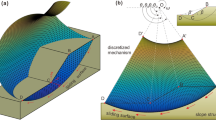Abstract
The paper presents a preliminary, simplified evaluation of the effects of rainfall infiltration on the stability of slopes in layered pyroclastic soils affected by shrinkage vertical fractures. The analysis has been developed with a special reference to a stratigraphic sequence obtained by an in situ survey at Pizzo d’Alvano (Southern Italy). The analysis of rainfall infiltration is performed using an original dual-permeability model. Results show how fractures strongly condition infiltration depending on rainfall intensity. Prolonged low-intensity rainfall may lead to a higher saturation of the surface soil layer than short, intense rainfall when water may flow quickly through fractures into the underlying more permeable soil layers. Calculated distributions of pore pressure are used for the slope stability analysis using the infinite slope approach. Variations of the safety factor as a consequence of infiltration show that prolonged rainfall can induce a more relevant decrease in the safety factor than intense precipitations.







Similar content being viewed by others
References
Basile A, Mele G, Terribile F (2003) Soil Hydraulic behaviour of a selected benchmark soil involved in the landslide of Sarno 1998. Geoderma 117:331–346
Bilotta E, Cascini L, Foresta V, Sorbino G (2005) Geotechnical characterization of pyroclastic soils involved in huge flowslides. Geotech Geol Eng 23:365–402
Cascini L, Sorbino G (2003) The contribution of soil suction measurements to the analysis of flowslide triggering. Workshop "Flows 2003—occurrence and mechanisms of flows in natural soils and earthfills". May 2003, 1:77–86
Cascini L, Cuomo S, Guida D (2008) Typical source areas of May 1998 flow-like mass movements in the Campania region, Southern Italy. Eng Geol 96:107–125
Crosta GB, Dal Negro P (2003) Observations and modelling of soil slip-debris flow initiation processes in pyroclastic deposits: the Sarno event. Nat Hazard Earth Sys 3:53–69
Del Prete M, Guadagno FM, Hawkins AB (1998) Preliminary report on the landslides of 5 May 1998, Campania, southern Italy. Bull Eng Geol Environ 57(2):113–129
Doglioni A, Galeandro A, Simeone V (2013) Lateral strength and critical depth in infinite slope stability analysis. Int J Numer Anal Methods Geomech. doi:10.1002/nag.2190 (in press)
Esposito L, Guadagno FM (1998) Some special geotechnical properties of pumice deposits. Bull Eng Geol Environ 57:41–50
Esposito L, Esposito AW, Pasculli A, Sciara N (2013) Particular features of the physical and mechanical characteristics of certain Phlegraean pyroclastic soils. Catena 104:186–194
Fiorillo F, Wilson RC (2004) Rainfall induced debris flows in pyroclastic deposits, Campania (southern Italy). Eng Geol 75:263–289
Fiorillo F, Guadagno FM, Aquino S, De Blasio A (2001) The December 1999 Cervinara landslides: further debris flows in the pyroclastic deposits of Campania (southern Italy). Bull Eng Geol Environ 60(3):171–184
Fredlung DG, Rahardjo H (1993) Soil mechanics for unsaturated soils. Wiley, New York
Galeandro A, Simeone V (2010) A dual porosity model for infiltration processes in fractured porous swelling soils. In: Proceedings of the 11th IAEG congress, geologically Active, Auckland NZ, 5–10 Sept 2010. pp 683–689
Galeandro A, Simeone V (2012) Infiltration processes in fractured and swelling soils and their influence on the stability of surficial covers. Rend Online Soc Geol It 21:518–520
Galeandro A, Šimůnek J, Simeone V (2011) Simulating infiltration processes into fractured and swelling soils as triggering factors of landslides. In: Margottini C, Canuti P, Sassa K (eds) Landslide science in practice, vol 3 Spatial analysis and modelling; chapter 1—Advances in slope modeling. (World Landslide Forum 2, Rome, October 2011)
Galeandro A, Doglioni A, Simeone V, Šimůnek J (2013a) Analysis of infiltration processes into fractured and swelling soils as triggering factors of landslides. Environ Earth Sci. doi:10.1007/s12665-013-2666-7 (in press)
Galeandro A, Simeone V, Šimůnek J (2013b) A dual-permeability model for simulating water infiltration into unsaturated, fractured and swelling soils. Rend Online Soc Geol It 24:152–154
Guadagno FM, Scarascia Mugnozza G, Martino S (2003) Influence of man-made cuts on the stability of pyroclastic covers (Campania, Southern Italy): a numerical modelling approach. Environ Geol 43:371–384
Guadagno FM, Forte R, Revellino P, Fiorillo F, Focaresta M (2005) Some aspects of the initiation of debris avalanches in the Campania region: the role of morphological slope discontinuities and the development of failures. Geomorphology 66:237–254
Iverson RM (2000) Landslide triggering by rain infiltration. Water Resour Res 36(7):1897–1910
Mancarella D, Simeone V (2012) Capillary barrier effects in unsaturated layered soils with special reference to the pyroclastic veneer of the Pizzo d’Alvano, Campania, Italy. Bull Eng Geol Environ 71:791–801. doi:10.1007/s10064-012-0419-6
Mancarella D, Doglioni A, Simeone V (2012) On capillary barrier effects and debris slide triggering in unsaturated layered covers. Eng Geol 147–148:14–27. doi:10.1016/j.enggeo.2012.07.003
Mualem Y (1976) A new model for predicting the hydraulic conductivity of unsaturated porous media. Water Resour Res 12:513–515
Olivares L, Picarelli L (2003) Shallow flowslides triggered by intense rainfalls on natural slopes covered by loose unsaturated pyroclastic soils. Geotechnique 53(2):283–288
Revellino P, Hungr O, Guadagno FM, Evans SG (2004) Velocity and runout simulation of destructive debris flows and debris avalanches in pyroclastic deposits, Campania region, Italy. Environ Geol 45:295–311
Skempton AW, De Lory FA (1957) Stability of natural slopes in London clay. Proc 4th Int Conf Soil Mech 2:378–381
Stormont JC, Morris CE (1998) Method to estimate water storage capacity of capillary barriers. J Geotech Geoenviron Eng 124(4):297–302
van Genuchten MTh (1980) A closed form equation for predicting the hydraulic conductivity of unsaturated soils. Soil Sci Soc Am J 44:892–898
Wieczorek GF (1996) Landslide triggering mechanisms. In: Turner AK, Shuster RL (eds) Landslides: investigation and mitigation. Transportation Research Board-National Research Council, Special report, vol 247, pp 76–90
Author information
Authors and Affiliations
Corresponding author
Rights and permissions
About this article
Cite this article
Galeandro, A., Šimůnek, J. & Simeone, V. Analysis of rainfall infiltration effects on the stability of pyroclastic soil veneer affected by vertical drying shrinkage fractures. Bull Eng Geol Environ 72, 447–455 (2013). https://doi.org/10.1007/s10064-013-0492-5
Received:
Accepted:
Published:
Issue Date:
DOI: https://doi.org/10.1007/s10064-013-0492-5




